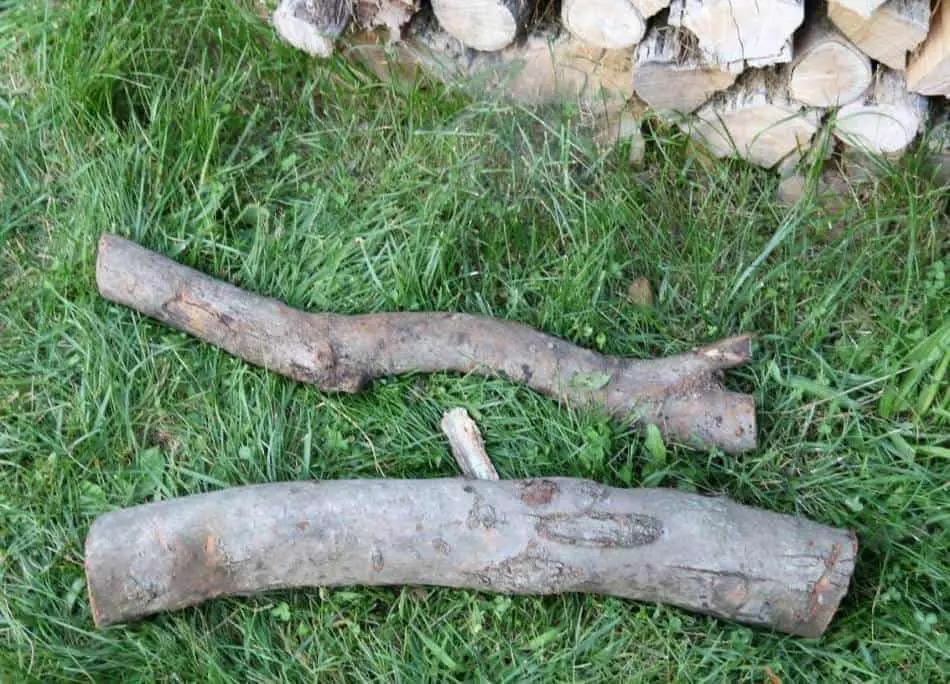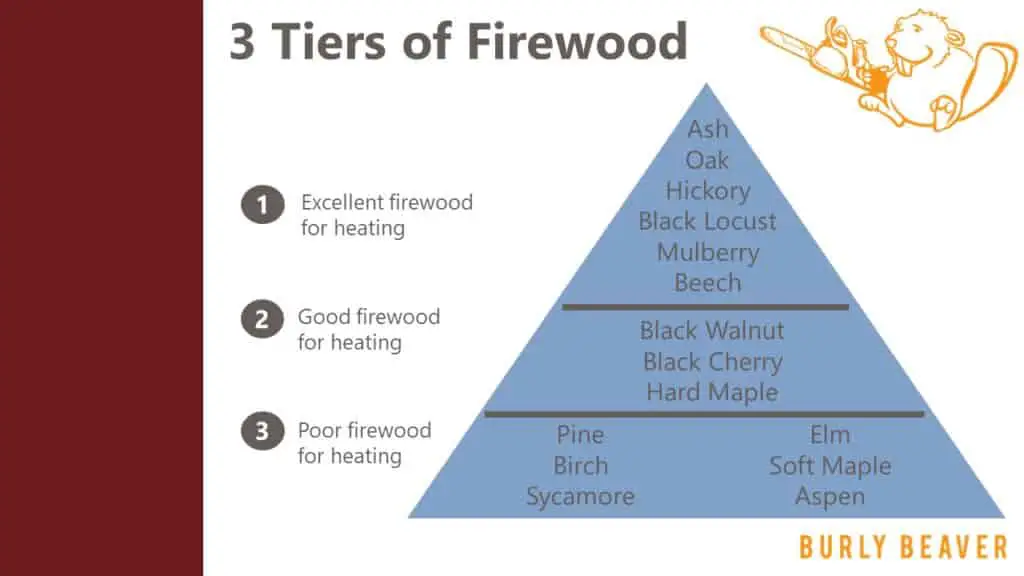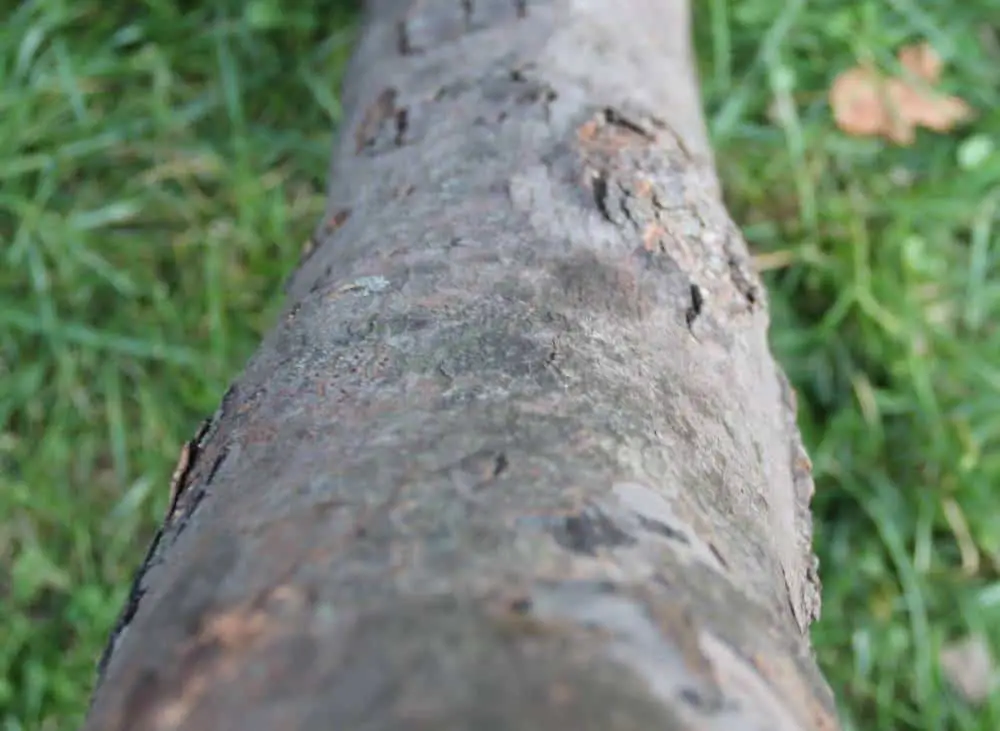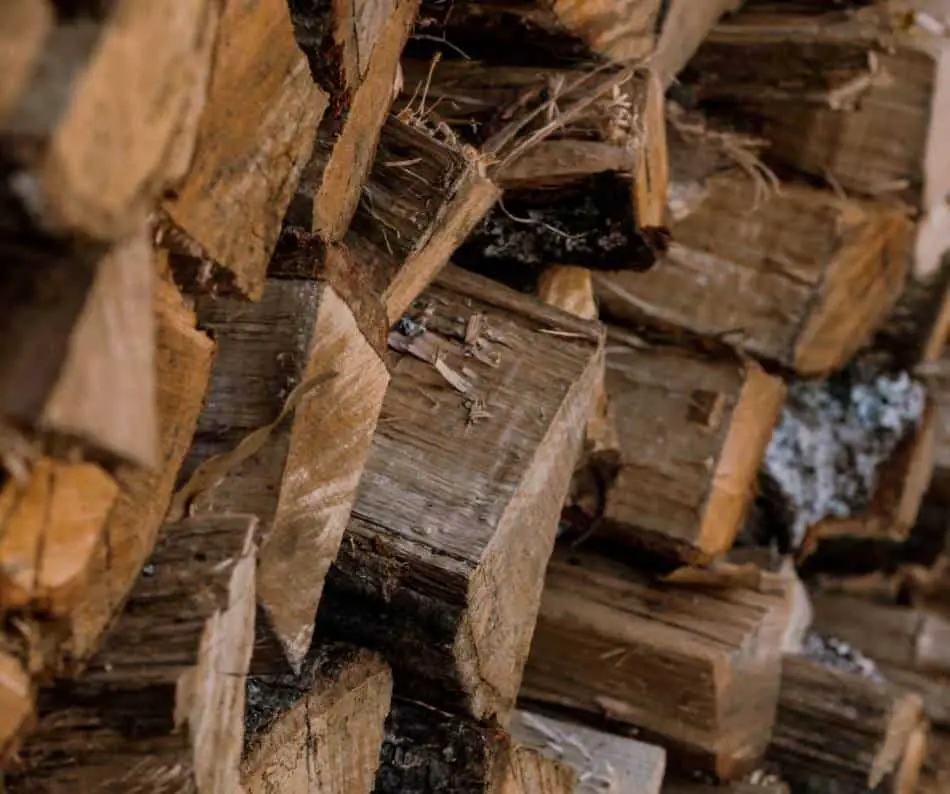
There are over 100 species of Maple trees, and this can make it really tricky to know what to expect from Maple when you’re using it as firewood.
But hey, that’s why you’re here, and with a few basic details, this whole topic becomes a lot simpler. Let’s dive-in, and we’ll start high-level:
Is Maple good firewood?
Maple firewood ranges from poor to moderately good firewood. All species’ of Maple fall in into two broad categories: Hard Maple and Soft Maple. Hard Maple is moderately good firewood, and Soft Maple is poor firewood. Hard Maple is denser than Soft Maple and produces a higher heat output.
Now, when we say soft Maple is “poor”, and Hard Maple is just “moderately good”, does that mean you shouldn’t use them? No!
Maple is a common type of wood, and both can still be good options, you will just want to know the details below before you throw it in the fire.
Maple vs. Other Firewood

To help you get an idea for how Maple compares to other types of firewood, we’ve put together a graphic below, which provides a snapshot of some of the most common types of firewood in our area (in the Midwest USA), and they are divided into 3 levels of quality.
The top tier (top of the pyramid) is the absolute best firewood you can burn, whereas the bottom of the pyramid is the firewood that will still produce heat, but is not ideal because of low heat output, excessive smoke, difficulty splitting, or some other reason.
This ranking is not an arbitrary list, and it’s actually based primarily on data from several university extension offices.
To learn more about the data sources, you can read the note below the image. Now, here it is!

The information in this image is based largely off of data from the following sources: Utah State University Forestry Extension, Oklahoma Cooperative Extension Service, University of Illinois Extension, University of Missouri Extension, South Dakota State University Extension. In addition, where there was missing data (only a few occasions), I’ve used my own experience to round out the data.
That gives you an idea of where Hard Maple and Soft Maple are in comparison to other types of firewood, and in the following section, we’ll highlight 6 important considerations for burning Maple firewood. Let’s go!
The 6 Burn Qualities of Maple

1. Heat Output vs Other Firewood
When it comes to heat output, Hard Maple is not bad, and it’s pretty close to Ash and Mulberry which both burn very hot. However, Soft Maple is TERRIBLE when it comes to heating.
To give you a clearer view of this, I compiled some side-by-side numbers. Check out the table below to see a more data-driven comparison of the heat output for 15 common firewood species’.
Both types of Maple are marked with bold text below. (Note: data sources are mentioned beneath the infographic above).
Heat Output of Common Firewood
| Species | BTUs | Weight/Cord (lbs) |
| Black Locust | 29.3 | 4192 |
| Hickory | 28.5 | 4072 |
| Beech | 27.5 | 3760 |
| Oak (White) | 26.4 | 3776 |
| Mulberry | 25.8 | 3712 |
| Ash | 24.2 | 3472 |
| Maple (Hard) | 23.9 | 3408 |
| Black Walnut | 22.2 | 3192 |
| Pine (Southern Yellow) | 22 | 2936 |
| Birch | 20.8 | 2992 |
| Sycamore | 24.1 | 2872 |
| Black Cherry | 20.4 | 2928 |
| Elm | 20 | 2872 |
| Maple (Soft) | 19 | 2752 |
| Aspen | 18.2 | 2160 |
Heat output is definitely an important characteristic for firewood, but it’s not the only thing that matters. There are a few other factors, that will affect how good the wood is for heating or for outdoor campfires.
Next up, let’s look at smoke output.
2. Amount of Smoke
This one is interesting, because in this area, Soft Maple is better than Hard Maple. Hard Maples (like Sugar Maple) are known to produce a lot of smoke, but Soft Maple produces much less smoke.
Similar to Hard Maple, Pine is also a firewood that produces a lot of smoke. On the other hand, some of our favorite firewoods like Hickory and Oak, create low levels of smoke.
High smoke production may also be a sign that wood is not fully dried, and you want to make sure that you’re always properly seasoning your wood before burning it. Jump down to this section to learn more about seasoning.
3. Does it Spark?
Some types of firewood pop or spark really badly, which may not seem like an issue at first, but it can actually be a big problem.
Wood that sparks heavily can create significant fire hazards, which can cause problems in both open-air (e.g. outdoor) and enclosed fireplaces. Mulberry is an example of a wood that sparks heavily.
Fortunately for us, both types of Maple produce very few sparks. Open-air fires should be monitored no matter what wood is used, but having firewood that is less prone to sparking does make a big difference.
4.Smell or Fragrance
Maple firewood has a nice aroma. It’s not quite as good as Cherry, or Hickory, which have famously good fragrances.
However, it’s still a nice campfire smell, and it’s definitely better than Buckeye, or Ailenthus, which both smell terrible when burned.
If you want to have the best smelling campfire of your life, you should definitely check out our article on the 11 best smelling types of firewood.
5. Does it Produce Coals?
Another factor that is commonly used for rating firewood is “coaling”. When any kind of firewood burns it produces coals, and the quality of the coals produced has a big impact on how long (and how well) the fire will continue burning.
Firewood that is on the top of the list for BTU output, tend to have very good coaling properties, and Maple actually performs really well on coaling also.
Even though Maple (hard and soft) is not as dense as Hickory and Black Locust, it still produces very good coals which will significantly outperform woods like Pine, Birch, or Aspen.
6. Creosote Build-Up
If you’re using a fireplace or wood stove in your home, another important thing to consider is the maintenance of your chimney, and specifically preventing creosote build-up.
If you’ve not heard of creosote before, it’s a side product of burning wood, and it’s basically a black tar that is gradually deposited by wood smoke on the inside walls of a chimney.
Creosote isn’t a problem in small quantities, but if it gets built up, it can be quite dangerous. Build-up of creosote can reduce the ventilation of your chimney, and it’s also HIGHLY flammable, which can cause chimney fires.
To prevent creosote build-up, it’s important to properly maintain your stove and to have your chimney cleaned regularly.
In addition, you should only ever burn wood that is thoroughly seasoned (dried), because wet wood produces more creosote. Another big factor is the type of wood you’re burning.
In general, firewood that is very sappy will produce much more creosote build-up than firewood that is not as sappy.
Most hardwood firewood, including Soft Maple and Hard Maple, have low sap levels and produce less creosote than very sappy firewood like Pine.
Speaking of Pine, it’s probably the worst type of wood when it comes to creosote build-up. Many people, including my family, completely avoid burning Pine in wood stoves as a result.
Burn Quality Overall Comparison

Alright, now that we’ve covered the 6 most important burning qualities for Maple, let’s boil it down to the biggest highlights.
- Maple has a low-to-moderate BTU output compared to other common firewoods, so it’s not the top choice if heating is your goal.
- Maple produces very good coals and even outperforms heavier types of wood in this category, including Ash and Walnut.
- Hard Maple produces a lot of smoke so you may want to avoid it if you are planning a cookout or campfire gathering.
Next, let’s touch briefly on identifying Maple firewood.
Identifying Maple Firewood

Everyone will agree, that the #1 easiest way to identify Maple, is by the leaf. The shape of a Maple leaf is probably the most famous of any tree (e.g. they’re on the Canadian flag).
So, if you have some leaves around, just go with that!
However, one of the tricky things about identifying firewood is that you often don’t have any leaves to go by, and that is the first way that most people learn for identifying trees.
So, we’re going to give you a couple tips for picking-out Maple even if you don’t have the leaves around.
In the picture below, I’ve got a piece of Maple wood. And you may notice right away, how tight (almost skin-like) the bark is.

This is a common trait for Maple trees, especially on the limbs and branches. And it is very different than many of our other common firewoods.
For example, Ash has big parallel ridges in its bark that almost looks like small wooden mountain ranges. And Hickory has bark that grows in thin “plates” that sometimes hang or flake off (like with Shagbark Hickory).
You can also use the end-grain of the wood to help with identification. Maple does NOT have rays that are visible to the naked eye, like Oak and Sycamore both do.
Rays are lines from the center of the wood to the outside, that run perpendicular to the annual rings, which you can use to count the age of a tree. So if you see rays, then it’s not Maple.
The color of the wood can also be helpful. Maple wood typically has a light-brown color, which separates it from Black Walnut (which is very dark), and Cherry which is red.
I’ll admit, this is not a 100% scientific approach, but if you’re in a similar environment (e.g. live in an area with similar trees and forestland) than these factors should work well.
Seasoning Maple Firewood
In general, firewood will take at least 6-8 months to fully season and for denser hardwoods, this process can take even longer. You should expect it to take 6-12 months to season Maple firewood.
For wood to be “seasoned” basically just means that it’s thoroughly dried, and you should always plan to burn firewood that is completely seasoned.

Exactly how long it will take depends on several factors, including the climate where you’re located (e.g. wood dries faster in Texas than in Oregon), and if you’ve properly split and stacked the wood.
In order to expedite the process, and to get your firewood seasoned as quickly as possible, use the following tips for fast drying:
5 Tips for Seasoning Firewood Fast
1. Split the firewood
firewood dries WAY faster when it is split into pieces, rather than sitting in log-form. Think about it, when the wood is split more surface area is exposed to the wind and sunshine, which are the primary contributors to dry wood.
2. Elevate the firewood
You may do a double take here, because a lot of people don’t do this step due to the extra effort required. And I’ll admit, this isn’t absolutely essential, but if you put your stack of firewood up on some pallets or perpendicular planks, it will increase airflow beneath the firewood stack and will accelerate your drying time.
3. Stack the firewood
To optimize your drying time, you should stack your firewood neatly in a location that will maximize the amount of sunshine and airflow. For example, stack the wood away from buildings (out of the shade), and point the face of the stack (not the ends) towards the direction from which you get the most breeze.
4. Leave space between rows
if you make multiple stacks of firewood, each stack should be separated by at least a few inches for airflow. This will allow both stacks of wood to dry better.
5. Cover (optional)
If your wood pile is outside you can put a cover or tarp over the stack to drain any rain/snow. Just make sure that it doesn’t totally block airflow from the side of the stack, otherwise it will trap in moisture and make seasoning take longer.
If you want to learn more about seasoning firewood, you should take a look at this article. And if you’re curious about whether you can dry your firewood under a shed or in your garage, you can read more in this article.
Related Questions
What is the Best Firewood?
The best type of firewood for heating a home with a wood stove, is Black Locust or Hickory, due to the high heat output and long-lasting coals. For outdoor campfires, Pine or Cedar are better because they produce a pleasant fire that doesn’t burn too long.
Is Maple a Hardwood?
Maple is a hardwood because it is a deciduous tree, meaning it loses its leaves every year. For a tree to be a hardwood is based on whether that tree is deciduous, not on the density of the wood. Softwood trees are conifers, like Pine, which are evergreen and have needles instead of leaves.